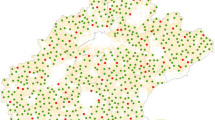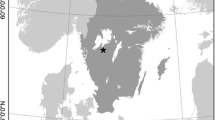Abstract
Together, the three particle size fractions (PSFs) of clay, silt, and sand are the most fundamental soil properties because the relative abundance influences the physical, chemical, and biological activities in soil. Unfortunately, determining PSFs requires a laboratory method which is time-consuming. One way to add value is to use digital soil mapping, which relies on empirical models, such as multiple linear regression (MLR), to couple ancillary data to PSFs. This approach does not account for the special requirements of compositional data. Here, ancillary data were coupled, via MLR modelling, to additive log-ratio (ALR) or isometric log-ratio (ILR) transformations of the PSFs to meet these requirements. These three approaches (MLR vs. ALR-MLR and ILR-MLR) were evaluated along with the use of different ancillary data that included proximally sensed gamma-ray spectrometry, electromagnetic induction, and elevation data. In addition, how the prediction might be improved was examined using ancillary data that was measured on transects and was compared to data interpolated from transects spaced far apart. Although the ALR-MLR approach did not produce significantly better results, it predicted soil PSFs that summed to 100 and had the advantage of interpreting the ancillary data relative to the original coordinates (i.e. clay, silt, and sand). For the prediction of PSFs at various depths, all ancillary data were useful. Elevation and gamma-ray data were slightly better for topsoil and elevation and electromagnetic (EM) data were better for subsoil prediction. In addition, a smaller transect spacing (26 m) and number of samples (9–16) might be adopted for mapping soil PSFs and soil texture across the study field. The ALR-MLR approach can be applied elsewhere to map the spatial distribution of clay minerals.
Similar content being viewed by others
References
Aitchison, J. (1990) Relative variation diagrams for describing patterns of compositional variability. Mathematical Geology, 22, 487–511.
Brus, D.J. (2015) Balanced sampling: a versatile sampling approach for statistical soil surveys. Geoderma, 253, 111–121.
Brus, D.J. and Saby, N.P.A. (2016) Approximating the variance of estimated means for systematic random sampling, illustrated with data of the French Soil Monitoring Network. Geoderma, 279, 77–86.
Buchanan, S., Triantafilis, J., Odeh, I.O.A., and Subansinghe, R. (2012) Digital soil mapping of compositional particle-size fractions using proximal and remotely sensed ancillary data. Geophysics, 77, WB201–WB211.
Carroll, Z.L. and Oliver, M.A. (2005) Exploring the spatial relations between soil physical properties and apparent electrical conductivity. Geoderma, 128, 354–374.
Cockx, L., Van Meirvenne, M., Vitharana, U.W.A., Verbeke, L.P.C., Simpson, D., Saey, T., and Van Coillie, F.M.B. (2009) Extracting topsoil information from EM38DD sensor data using a neural network approach. Soil Science Society of America Journal, 73, 2051–2058.
De Benedetto, D., Castrignano, A., Sollitto, D., Modugno, F., Buttafuoco, G., and lo Papa, G. (2012) Integrating geophysical and geostatistical techniques to map the spatial variation of clay. Geoderma, 171, 53–63.
De Gruijter, J.J., Walvoort, D.J.J., and van Gaans, P.F.M. (1997) Continuous soil maps — a fuzzy set approach to bridge the gap between aggregation levels of process and distribution models. Geoderma, 77, 169–195.
Domsch, H. and Giebel, A. (2004) Estimation of soil textural features from soil electrical conductivity recorded using the EM38. Precision Agriculture, 5, 389–409.
Doolittle, J.A. and Brevik, E.C. (2014) The use of electromagnetic induction techniques in soils studies. Geoderma, 223, 33–45.
Egozcue, J.J., Barceló-Vidal, C., Martin-Fernández, J.A., Jarauta-Bragulet, E., Díaz-Barrero, J.L., and Mateu-Figueras, G. (2011) Elements of simplicial linear algebra and geometry. Pp. 139–157 in: Composition Data Analysis: Theory and Applications (V. Pawlowsky-Glahn and A. Buccianti, editors). DOI: https://doi.org/10.1002/9781119976462, John Wiley & Sons.
Egozcue, J.J., Pawlowsky-Glahn, V., Mateu-Figueras, G., and Barceló-Vidal, C. (2003) Isometric log ratio transformations for compositional data analysis. Mathematical Geology, 35, 279–300.
Filzmoser, P., Hron, K., and Reimann, C. (2009) Principal component analysis for compositional data with outliers. Environmetrics, 20, 621–632.
Grasty R.L., Holman, P.B., and Blanchard, Y.B. (1991) Transportable calibration pads for ground and airborne gamma-ray spectrometers. Geological Survey of Canada, 90, 23.
Huang, J., Lark, R.M., Robinson, D.A., Lebron, I., Keith, A.M., Rawlins, B., and Triantafilis, J. (2014) Scope to predict soil properties at within-field scale from small samples using proximally sensed γ-ray spectrometer and EM induction data. Geoderma, 232, 69–80.
Hedley, C.B., Yule, I.J., Eastwood, C.R., Shepherd, T.G., and Arnold, G. (2004) Rapid identification of soil textural and management zones using electromagnetic induction sensing of soils. Australian Journal of Soil Research, 42, 389–400.
Heil, K. and Schmidhalter, U. (2012) Characterisation of soil texture variability using the apparent soil electrical conductivity at a highly variable site. Computational Geosciences, 39, 98–110.
Huang, J., Subasinghe, R., and Triantafilis, J. (2014) Mapping particle-size fractions as a composition using additive log-ratio transformation and ancillary data. Soil Science Society of America Journal, 78, 1967–1976.
Huang, J., Barrett-Lennard, E.G., Kilminster, T., Sinnott, A., and Triantafilis, J. (2015) An error budget for mapping field-scale soil salinity at various depths using different sources of ancillary data. Soil Science Society of America Journal, 79, 1717–1728.
Hwang, S.I., Lee, K.P., Lee, D.S., and Powers, S.E. (2002) Models for estimating soil particle-size distributions. Soil Science Society of America Journal, 66, 1143–1150.
Isbell, R. (2002) The Australian Soil Classification. Australian Soil and Land Survey Handbooks. Series 4, CSIRO Publishing, Australia.
Jung, W.K., Kitchen, N.R., Sudduth, K.A., and Anderson, S.H. (2006) Spatial characteristics of claypan soil properties in an agricultural field. Soil Science Society of America Journal, 70, 1387–1397.
Lark, R.M. and Bishop T.F.A. (2007) Cokriging particle size fractions of the soil. European Journal of Soil Science, 58, 763–774.
Lark, R.M., Cullis, B.R. and Welham, S.J. (2006) On spatial prediction of soil properties in the presence of a spatial trend: The empirical best linear unbiased predictor (E-BLUP) with REML. European Journal of Soil Science, 57, 787–799.
Lin, L.I.K. (1989) A condordance correlation coefficient to evaluate reproducibility. Biometrics, 45, 255–268.
Minasny, B. and McBratney, A.B. (2006) Latin hypercube sampling as a tool for digital soil mapping. Developments in Soil Science, 31, 153–606.
Minasny, B., McBratney, A.B., and Whelan, B.M. (1999) Computer Program for Variogram Estimation and Spatial Prediction with Error. Australian Centre for Precision Agriculture Sydney, Australia.
Odeh, I.O.A., Todd, A.J., and Triantafilis, J. (2003) Spatial prediction of soil particle-size fractions as compositional data. Soil Science, 168, 501–515.
Pawlowsky-Glahn, V. and Egozcue, J.J. (2016) Spatial analysis of compositional data: A historical review. Journal of Geochemical Exploration, 164, 28–32.
Petersen, H., Wunderlich, T., Attia al Hagrey, S., and Rabbel, W. (2012) Characterization of some middle European soil textures by gamma spectrometry. Journal of Plant Nutrition and Soil Science, 175, 651–660.
Pracilio, G., Adams, M.L. Smettem, K.R.J., and Harper, R.J. (2006) Determination of spatial distribution patterns of clay and plant available potassium contents in surface soils at the farm scale using high resolution gamma ray spectrometry. Plant and Soil, 282, 67–82.
Rayment, G.E. and Higginson, F.R. (1992) Australian Laboratory Handbook of Soil and Water Chemical Methods. Inkata Press, Port Melbourne, Australia.
Spadoni, M. and Voltaggio, M. (2013) Contribution of gamma ground spectrometry to the textural characterization and mapping of floodplain sediments. Journal of Geochemical Exploration, 125, 20–33.
Sudduth, K.A., Kitchen, N.R. Myers, D.B., and Drummond, S.T. (2010) Mapping depth to argillic soil horizons using apparent electrical conductivity. Journal of Environmental & Engineering Geophysics, 15, 135–146.
Sumner, M.E. (editor) (1999) Handbook of Soil Science. CRC Press, Boca Raton, Florida, USA.
Triantafilis, J., Huckel, A.I., and Odeh, I.O.A. (2001) Comparison of statistical prediction methods for estimating field-scale clay content using different combinations of ancillary variables. Soil Science, 166, 415–427.
Triantafilis, J., Gibbs, I., and Earl, N. (2013) Digital soil pattern recognition in the lower Namoi valley using numerical clustering of gamma-ray spectrometry data. Geoderma, 192, 407–421.
Viscarra Rossel, R.A., Taylor, H.J., and McBratney, A.B. (2007) Multivariate calibration of hyperspectral γ-ray energy spectra for proximal soil sensing. European Journal of Soil Science, 58, 343–353.
Vitharana, U.W.A., Van Meirvenne, M., Simpson, D., Cockx, L., and De Baerdemaeker, J. (2008) Key soil and topographic properties to delineate potential management classes for precision agriculture in the European loess area. Geoderma, 143, 206–215.
Webster, R. and Oliver, M.A. (1992) Sample adequately to estimate variograms of soil properties. Journal of Soil Science, 43, 177–192.
Webster, R. and Oliver, M.A. (2007) Geostatistics for Environmental Scientists. John Wiley & Sons, New Jersey, USA.
Williams, B.G. and Hoey, D. (1987) The use of electromagnetic induction to detect the spatial variability of the salt and clay contents of soils. Australian Journal of Soil Research, 25, 21–27.
Wilson, P.R. and Baker, D.E. (1990) Soils and agricultural land suitability of the wet tropical coast on north Queensland: Ingham area. Land Resources Bulletin, Queensland Department of Primary Industries, Queensland Government Technical Report, 146 pp.
Author information
Authors and Affiliations
Corresponding author
Rights and permissions
About this article
Cite this article
Muzzamal, M., Huang, J., Nielson, R. et al. Mapping Soil Particle-Size Fractions Using Additive Log-Ratio (ALR) and Isometric Log-Ratio (ILR) Transformations and Proximally Sensed Ancillary Data. Clays Clay Miner. 66, 9–27 (2018). https://doi.org/10.1346/CCMN.2017.064074
Received:
Revised:
Published:
Issue Date:
DOI: https://doi.org/10.1346/CCMN.2017.064074




